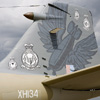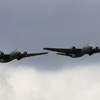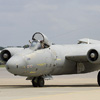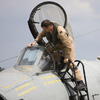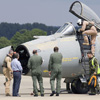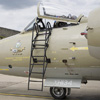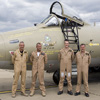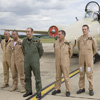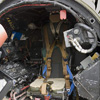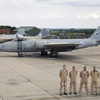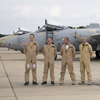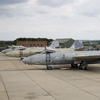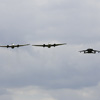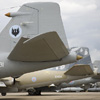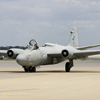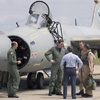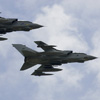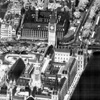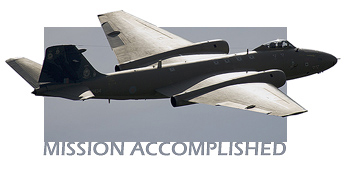
Canberra PR9 Final Deployment Feature Report
Friday 23rd June
June 23rd saw the end of the RAF's Photo Reconnaissance Unit's last overseas operational deployment. This occasion marked not just another "End of an era", but the upcoming retirement of the most successful and long lived British military jet. Two Canberras from 39 Squadron returned to RAF Marham, flying in formation with a pair of based Tornado GR4s. As they taxied to the hardstand the popular aircrew were applauded by welcoming staff and families.
was there to witness this historical event. All photography by the author unless otherwise stated.
The two aircraft were crewed by Flt Lt Ronnie Fairbrother and Navigator Sqn. Ldr. Winny Winwright in XH135, and Flt Lt Mike Leckey and Navigator Flt Lt Colin "Deep Fat" Fryer in XH131. They had just flown the last leg of the journey back from the Middle East, a three hour flight from Italy. The two aircraft looked as if they had been busy during the four-month long detachment. The temporary grey ARTF camouflage starting to show wear and tear, compared with the immaculately finished XH134, the specially marked display aircraft they flanked as they were lined up together on the apron.
Exactly what the aircraft had been up to is of course classified, but in the age of satellite imagery and sensing, the capabilities of the Canberra have been continuously updated and having the flexibility of a manned aircraft obviously has its benefits. Some reconnaissance capabilities can be performed by aircraft such as the Tornado, but the PR9 Canberra remains the only aircraft in the inventory capable of the high altitudes required for its unique role. The main reason for the retirement is the number of pressurisation cycles available on the remaining three airframes. Every time the aircraft climbs to altitude the fatigue life is reduced due to stresses on the fuselage due to the internal pressure necessary to keep the crew alive at high altitude.
The aircraft were built around 45 years ago by Shorts of Belfast, who were also responsible for the re-design and flight testing programme. 23 aircraft were eventually built, although only 21 of these entered RAF service, the first of these in April 1960. The improvements over the "basic" B2 were increased wingspan, a revised nose to house the Navigator and larger engine nacelles to suit the Avon RA.24. These modifications were to result in the PR9 being a very stable platform at the altitudes it was intended to operate at, usually in the region of 50,000 feet although the maximum operating ceiling is given as c70,000 ft. This was one reason for the Canberra’s longevity as it performed better than the Lockheed U2 family with similar equipment, but without needing the complex computerised stabilising kit.
Photo reconnaissance was the task when the PR9 entered service, but as technology developed various imaging sensors and navigation equipment were added to its repertoire. These include Infra red linescan (IRLS) Global Positioning System (GPS) Decca Tactical Air Navigation System (TANS) and the Goodrich Corporation Rapid Deployment Electro-Optical System (RADEOS) developed from the Senior Year Electro-Optical Relay System (SYERS) carried by the U-2S. Recently de-classified images shown in the press hint at the capabilities, with images of the Houses of Parliament taken from 47,000ft over the Isle of Wight, the time on Big-Ben can be clearly seen.
The retirement of the PR9 will see an end to the high altitude photo reconnaissance capability of the RAF. How this gap will eventually be filled, either by purchasing information from the USA, or reliance on UAV or satellite imagery remains to be seen.
The retirement will also see the end of various trades in the RAF, most notably carpenters, as part of the Canberra’s tail is made from fabric covered wood.
The last three were put up for sale by auction, the displays at RAF Waddington and RAF Fairford (RIAT) being official viewing for prospective buyers. A wonderful if short display was performed on each day at both these shows by Sqn. Ldr. Terry Cairns. On the 18th July XH134 made an extensive tour of the country, over flying RAF stations and establishments associated with the Canberra. There remains one airframe at RAF Marham, the engineless XH169, destined to become a gate guardian, if the outgoing Station Commander’s wishes are met. The final RAF Canberra display was performed at the 39Squadron disbandment, where to most observers’ astonishment the display included two rolls.
All three eventually found their way to the former RAF station at Kemble airfield in Gloucestershire on July 31st.
The Canberra whose service life spans more than half the life of the RAF has served the force well, from the Cuba missile crisis to Afghanistan. It has won the respect and affection of more than one generation and will be sadly missed by most service personnel involved with it. Hopefully the new owners will keep at least one PR9 in airworthy condition, to be enjoyed by future air show visitors.
